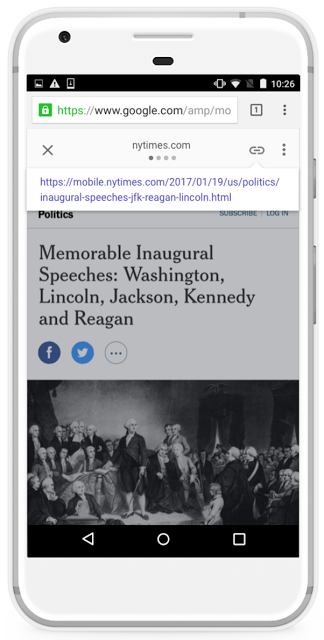
One of the main drawbacks of Google AMP has been brand confusion when viewing and sharing articles. Google launched the AMP project to speed up the mobile web, but in exchange publishers have had to give up control of how their AMP’d content appears. One of the most irksome aspects of interacting with AMP pages is the convoluted URL structure, which causes users to be hesitant to share the content.
AMP appends google.com/amp/ to the beginning of the URL when copying the link, opening it in a browser, or sharing an article. Visitors who want to find the canonical URL have to return to Google to search for it. To the casual observer, it appears the visitor has landed on and is attempting to share a Google story.
After nearly a year, Google is finally looking to remedy this sharing problem with an update to the AMP Viewer header. In a post on the Google Developers blog, the company officially recognized this problem and announced a change that will allow visitors to share the canonical URL:
Many users have requested a way to access, copy, and share the canonical URL of a document. Today, we’re adding support for this functionality in form of an anchor button in the AMP Viewer header on Google Search. This feature allows users to use their browser’s native share functionality by long-tapping on the link that is displayed.

The updated header with the anchor button is already available on the iOS Google app and will be coming to the Android app within a few weeks. Google is also working on using the Web Share API to let visitors use the platform’s native sharing flow with the original URL instead of the AMP viewer URL.
“A thriving ecosystem is very important to us and attribution, user trust, and ownership are important pieces of this ecosystem,” Alex Fischer, Google software engineer, said.
The ability to share the canonical URL is good news for existing AMP users but is probably not enough to convince skeptical publishers to start AMPing up their pages. Burying the publisher’s canonical link is just one of many reasons there has been such strong push back against the AMP project.
Kyle Schreiber, whose post on the problems with AMP inspired discussions on Hacker News and Reddit, believes that “AMP is bad for the open web and should be changed or eliminated.”
Schreiber contends that Google has designed AMP to keep the visitor within its own ecosystem. Publishers get locked in when access to Google’s news carousel is reserved for AMP’d sites only.
“Clicking on an AMP link feels like you never even leave the search page, and links to AMP content are displayed prominently in Google’s news carousel,” Schreiber said.
Last year the Wall Street Journal spoke with publishers who were critical with AMP but reluctant to speak publicly for fear of Google’s retaliation. Their AMP pages were generating around half as much revenue as pageviews on their full mobile sites due to Google’s limitations on the type of ad units available for AMP pages. Google’s response was that the company aims to drive more revenue to non-AMP pages but isn’t quite there yet.
At the end of February the AMP project experiment will have been publicly launched for a year but many smaller publishers are still hesitant to get on board. They are concerned that AMP oversteps its reach without delivering enough value in return. The strategy of taking an absurd amount of control over publishers’ content and then slowly doling it back out (as with the new button for sharing the canonical URL) demonstrates how easily Google has established itself as the de facto arbiter of the mobile web. If publishers continue to yield control of their mobile content, Google will have every incentive to make AMP support the next official ranking signal.
So how will people know what the anchor is for, or realise to click on it? Also, what will sharing a content by other means do? Such as sharing an AMP page via a built in IOS mechanism, such as the built in mechanism to share on Twitter, for example? At first glance, this all sounds like a terrible ‘solution’ – although I may well be wrong of course… I’ll have to see it in the wild to really pass any kind of real judgement I guess…